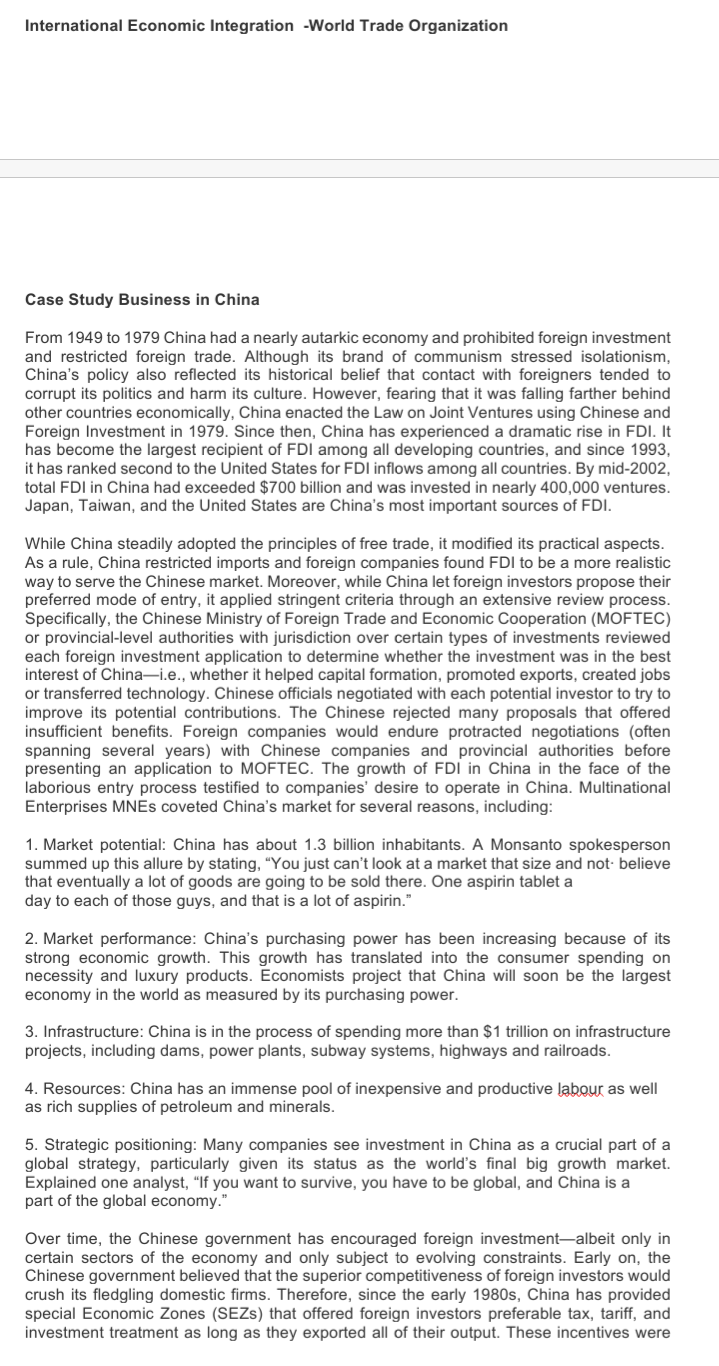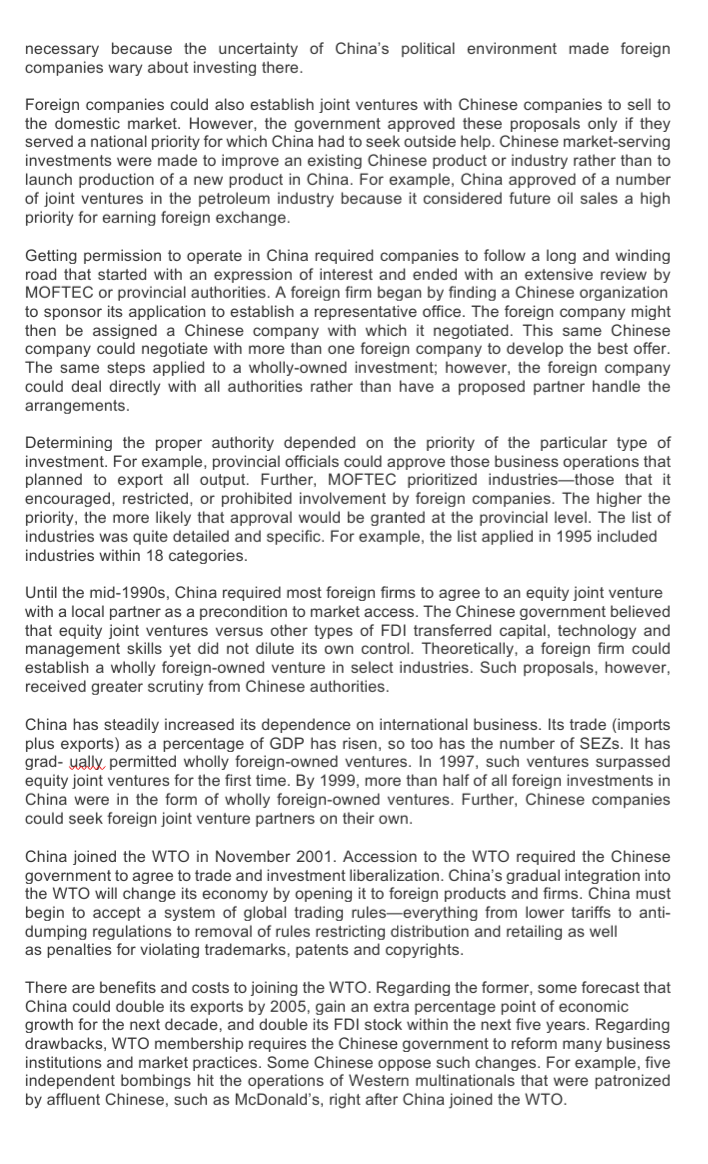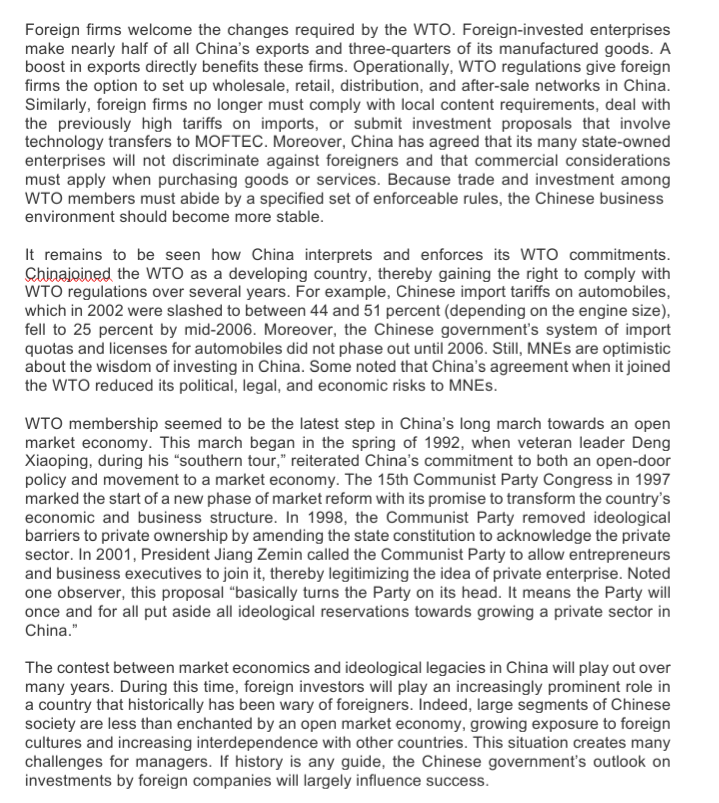Question
1. Profile the evolution of the Chinese business environment. Does this evolution strike you as predictable or unpredictable? Why would its degree of predictability matter
1. Profile the evolution of the Chinese business environment. Does this evolution strike you as predictable or unpredictable? Why would its degree of predictability matter to foreign investors?
2. Do you think the benefits of operating in China outweigh the risks?
3. What would you advise a company to do to maximize its rewards and to limits its risks?
4. Is it reasonable to expect China to adopt and fully enforce WTO regulations, particularly regarding intellectual property rights, in the next few years? If it chooses not to do so, what options would companies have to protect their interests?
5. How do you think the contest between market economics and ideological legacies will play out in China over the next ten years?



International Economic Integration -World Trade Organization Case Study Business in China From 1949 to 1979 China had a nearly autarkic economy and prohibited foreign investment and restricted foreign trade. Although its brand of communism stressed isolationism, China's policy also reflected its historical belief that contact with foreigners tended to corrupt its politics and harm its culture. However, fearing that it was falling farther behind other countries economically, China enacted the Law on Joint Ventures using Chinese and Foreign Investment in 1979. Since then, China has experienced a dramatic rise in FDI. It has become the largest recipient of FDI among all developing countries, and since 1993, it has ranked second to the United States for FDI inflows among all countries. By mid-2002, total FDI in China had exceeded $700 billion and was invested in nearly 400,000 ventures. Japan, Taiwan, and the United States are China's most important sources of FDI. While China steadily adopted the principles of free trade, it modified its practical aspects. As a rule, China restricted imports and foreign companies found FDI to be a more realistic way to serve the Chinese market. Moreover, while China let foreign investors propose their preferred mode of entry, it applied stringent criteria through an extensive review process. Specifically, the Chinese Ministry of Foreign Trade and Economic Cooperation (MOFTEC) or provincial-level authorities with jurisdiction over certain types of investments reviewed each foreign investment application to determine whether the investment was in the best interest of China-i.e., whether it helped capital formation, promoted exports, created jobs or transferred technology. Chinese officials negotiated with each potential investor to try to improve its potential contributions. The Chinese rejected many proposals that offered insufficient benefits. Foreign companies would endure protracted negotiations (often spanning several years) with Chinese companies and provincial authorities before presenting an application to MOFTEC. The growth of FDI in China in the face of the laborious entry process testified to companies' desire to operate in China. Multinational Enterprises MNEs coveted China's market for several reasons, including: 1. Market potential: China has about 1.3 billion inhabitants. A Monsanto spokesperson summed up this allure by stating, "You just can't look at a market that size and not believe that eventually a lot of goods are going to be sold there. One aspirin tablet a day to each of those guys, and that is a lot of aspirin." 2. Market performance: China's purchasing power has been increasing because of its strong economic growth. This growth has translated into the consumer spending on necessity and luxury products. Economists project that China will soon be the largest economy in the world as measured by its purchasing power. 3. Infrastructure: China is in the process of spending more than $1 trillion on infrastructure projects, including dams, power plants, subway systems, highways and railroads. 4. Resources: China has an immense pool of inexpensive and productive labour as well as rich supplies of petroleum and minerals. 5. Strategic positioning: Many companies see investment in China as a crucial part of a global strategy, particularly given its status as the world's final big growth market. Explained one analyst, "If you want to survive, you have to be global, and China is a part of the global economy." Over time, the Chinese government has encouraged foreign investment-albeit only in certain sectors of the economy and only subject to evolving constraints. Early on, the Chinese government believed that the superior competitiveness of foreign investors would crush its fledgling domestic firms. Therefore, since the early 1980s, China has provided special Economic Zones (SEZs) that offered foreign investors preferable tax, tariff, and investment treatment as long as they exported all of their output. These incentives were
Step by Step Solution
There are 3 Steps involved in it
Step: 1
1 The evolution of the Chinese business environment can be seen as a combination of predictable and unpredictable factors On one hand there has been a consistent trend towards economic liberalization ...
Get Instant Access to Expert-Tailored Solutions
See step-by-step solutions with expert insights and AI powered tools for academic success
Step: 2

Step: 3

Ace Your Homework with AI
Get the answers you need in no time with our AI-driven, step-by-step assistance
Get Started


